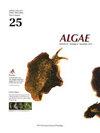Incorporating concepts of biodiversity into modern aquaculture: macroalgal species richness enhances bioremediation efficiency in a lumpfish hatchery
IF 2.4
3区 生物学
Q1 MARINE & FRESHWATER BIOLOGY
引用次数: 0
Abstract
Aquaculture is one of the fastest growing food producing sectors; however, intensive farming techniques of finfish have raised environmental concerns, especially through the release of excessive nutrients into surrounding waters. Biodiversity has been widely shown to enhance ecosystem functions and services, but there has been limited testing or application of this key ecological relationship in aquaculture. This study tested the applicability of the biodiversity-function relationship to integrated multi-trophic aquaculture (IMTA), asking whether species richness can enhance the efficiency of macroalgal bioremediation of wastewater from finfish aquaculture. Five macroalgal species (Chondrus crispus, Fucus serratus, Palmaria palmata, Porphyra dioica, and Ulva sp.) were cultivated in mono- and polyculture in water originating from a lumpfish (Cyclopterus lumpus) hatchery. Total seaweed biomass production, specific growth rates (SGR), and the removal of ammonium (NH4 +), total oxidised nitrogen (TON), and phosphate (PO4 3-) from the wastewater were measured. Species richness increased total seaweed biomass production by 11% above the average component monoculture, driven by an increase in up to 5% in SGR of fast-growing macroalgal species in polycultures. Macroalgal species richness further enhanced ammonium uptake by 25%, and TON uptake by nearly 10%. Phosphate uptake was not improved by increased species richness. The increased uptake of NH4 + and TON with increased macroalgal species richness suggests the complementary use of different nitrogen forms (NH4 + vs. TON) in macroalgal polycultures. The results demonstrate enhanced bioremediation efficiency by increased macroalgal species richness and show the potential of integrating biodiversity- function research to improve aquaculture sustainability.将生物多样性的概念纳入现代水产养殖:大型藻类物种丰富度提高了块鱼孵化场的生物修复效率
水产养殖是增长最快的食品生产部门之一;然而,鳍鱼的集约养殖技术引起了环境问题,尤其是通过向周围水域释放过量营养物质。生物多样性已被广泛证明可以增强生态系统的功能和服务,但在水产养殖中对这一关键生态关系的测试或应用有限。本研究测试了生物多样性-功能关系在综合多营养水产养殖(IMTA)中的适用性,询问物种丰富度是否可以提高大型藻类生物修复鳍鱼养殖废水的效率。五种大型藻类(软骨藻(Chondrus crispus)、岩藻(Fucus serratus)、掌叶棕榈(Palmaria palmata)、斑藻(Porphyra dioica)和Ulva sp。测量了海藻总生物量的产生、比生长速率(SGR)以及从废水中去除铵(NH4+)、总氧化氮(TON)和磷酸盐(PO4-)的情况。物种丰富度使海藻总生物量产量比单一栽培的平均成分高出11%,这是由于多栽培中快速生长的大型藻类物种的SGR增加了5%。大型藻类物种的丰富度进一步提高了25%的铵吸收和近10%的TON吸收。物种丰富度的增加并没有改善磷酸盐的吸收。随着大型藻类物种丰富度的增加,NH4+和TON的吸收增加,这表明在大型藻类复合培养中不同氮形式(NH4+与TON)的互补使用。结果表明,通过增加大型藻类物种的丰富度,生物修复效率得到了提高,并显示了整合生物多样性功能研究以提高水产养殖可持续性的潜力。
本文章由计算机程序翻译,如有差异,请以英文原文为准。
求助全文
约1分钟内获得全文
求助全文
来源期刊

Algae
PLANT SCIENCES-
CiteScore
5.10
自引率
25.00%
发文量
18
期刊介绍:
ALGAE is published by the Korean Society of Phycology and provides prompt publication of original works on phycology. ALGAE publishes articles on all aspects of phylogenetics and taxonomy, ecology and population biology, physiology and biochemistry, cell and molecular biology, and biotechnology and applied phycology. Checklists or equivalent manu-scripts may be considered for publication only if they contribute original information on taxonomy (e.g., new combinations), ecology or biogeography of more than just local relevance. Contributions may take the form of Original Research Articles, Research Notes, Review Articles and Book Reviews.
 求助内容:
求助内容: 应助结果提醒方式:
应助结果提醒方式:


